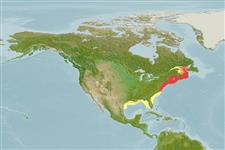Classificação / Names
Common names from other countries
Referência principal
Tamanho / Peso / Idade
Max length : 76.0 cm TL macho/indeterminado; (Ref. 6885); 61.7 cm SL (female); common length : 50.0 cm SL macho/indeterminado; (Ref. 188); Peso máx. publicado: 5.5 kg (Ref. 7251); Idade máx. registada: 13 anos (Ref. 72462)
Length at first maturity
Lm ?, range 38 - 48.5 cm
Ambiente
; marinhas; Água doce; estuarina; anádromo (Ref. 51243); intervalo de profundidade 0 - 250 m (Ref. 6793)
Clima / Intervalo
Temperate, preferred 10°C (Ref. 107945); 61°N - 22°N, 115°E - 59°W (Ref. 188)
Distribuição
North America: Newfoundland (Ref. 1998), the St. Lawrence River, and Nova Scotia southward to central Florida. Due to introductions into the Sacramento and Columbia Rivers, this species is now found from Cook Inlet, Alaska (Ref. 1998) to Baja California in Mexico and the Kamchatka Peninsula.
Países | Áreas FAO | Ecossistemas | Ocorrências | Introduções
Descrição breve
Espinhos dorsais (total): 0; Raios dorsais moles (total): 15-19; Espinhos anais 0; Raios anais moles: 18 - 24; Vértebras: 51 - 60. Moderately compressed, belly with a distinct keel. Lower jaw not rising steeply within mouth. Gill rakers long and slender (fewer in young). Silvery in color with blue or blue-green metallic luster on back (Ref. 1998). A dark spot on shoulder, sometimes followed by several more, or even a second row. Resembles A. pseudoharengus with lower jaw rising steeply within mouth, eyes larger, and fewer lower gill rakers, as also A. aestivalis and A. mediocris (Ref. 188). Silvery, with a green or bluish back (Ref. 7251). Branchiostegal rays 7 (Ref. 4639).
Categoria na Lista Vermelha da IUCN (Ref. 115185)
Ameaça para o homem
Harmless
Utilização humana
Pescarias: espécies comerciais; peixe desportivo: sim
Mais informação
ColaboradoresFotografiasStamps, CoinsSonsCiguateraVelocidadeTipo de nataçãoÁrea branquialOutras referênciasCérebrosVisão
Ferramentas
Relatórios especiais
Descarregue XML
Fontes da internet
Estimates of some properties based on models
Phylogenetic diversity index
PD50 = 0.5000 many relatives (e.g. carps) 0.5 - 2.0 few relatives (e.g. lungfishes)
Nível Trófico
3.5 ±0.3 se; Based on diet studies.
Resiliência
Baixo, tempo mínimo de duplicação da população 4,5 - 14 anos (K=0.14; tm=4.7)
Vulnerabilidade
Moderate to high vulnerability (51 of 100)
Categoria de preço
